|
Dennis Rader - BTK killer - A biography
1990-2003
It's not known what work Dennis Rader had, if any, into early 1991,
but he was into another PJ in January 1991. Now 45 years old, he was
wary of PJs involving younger women or where a male was present. He saw
older women as more vulnerable.
Encounters with younger ladies had been difficult when they fought
back. Males were just obstacles in the way of his intended conquests.

Rader focused his attentions on an older woman who lived alone, 62
year old Dolores Davis. She only lived about a mile and a half from
where he did, but there is no indication he was personally acquainted
with her.
Dolores had moved to the Park City area after years an an executive
secretary in Wichita and was renting a house in an area without close
neighbors. This undoubtedly piqued Rader's interest. He noticed her at
her home one day and might have done some snooping or investigating to
confirm her status as a single woman living alone.
This would be another well-planned project. Using the pretext of
being away for the weekend on a Scout camping outing in Harvey County,
just to the north of Sedgwick County where Rader resided, he again
invented an excuse to slip away from camp in the evening. It was a very
cold night, below freezing.
He drove back to his parents' home in north Wichita (apparently they
may have been away that weekend) and changed out of his Scout uniform
into his hit clothes. Rader then drove to the Baptist Church in Park
City and parked his car, and set out on foot for the Davis residence.
When he got there Dolores was still awake and reading in bed. He
waited out in the cold for her to turn off the light and go to sleep.
Using a cement block taken from a shed in the backyard, he rammed the
sliding glass door at the rear of the house.
Dolores came out of the bedroom thinking someone had driven into her
house, but there was Rader. He launched into the familiar line of being
a vagrant in need of food, money and a car and told her he had to tie
her up.
There are indications from the crime scene that a struggle did take
place, but Rader succeeded in tying her up in the bedroom. It's not
known how long Rader lingered there, but Dolores helped to ruin his
party by telling him she was expecting someone to arrive any minute. He
ended her life by ligature strangulation. (Rader made a sketch of her
final moments at a time soon after this murder).
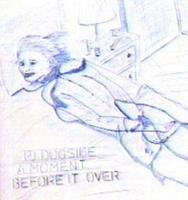
Rader dragged the body outside and put it in the trunk of her car.
He only drove a short distance to a lake area near I-135 by Park City
and left the body and other evidence there under some trees.
He then drove the car back to the Davis house and wiped it down for
fingerprints, tossing the keys onto the roof. Rader then set out on foot,
walking in a roundabout fashion back to the Baptist Church. Driving his
own car, he returned to where he left the body and put it in his car.
He meandered around to the north, and settled on a remote spot
underneath a bridge in northern Sedgwick County as the dumping spot.
After leaving her there, he went somewhere to change back into his Scout
uniform and returned to camp.
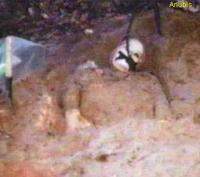
The following night he left camp again to come back to the dumping
spot to pose and photograph the body. Rader says he had an encounter
with a police officer at a place where he had to change clothes, but was
let go after a few questions. (Soon after the murder, Rader took a photo
of himself buried in a grave he says he had dug for Dolores Davis,
wearing a mask and using a Polaroid camera activated with a mechansim
triggered via a cord.)

Only four months after this episode Rader was hired by Park City as
compliance and animal control officer. He became a combination
dogcatcher and local code enforcer. He was now part of the local law
establishment. He gained a varying reputation ranging from efficient and
friendly to overzealous and petty,writing citations if a lawn exceeded
six inches in grass height.
There were complaints against him, and several people were said to
have moved away from Park City due to his mistreatment. No complaint
ever resulted in disciplinary action, as local officials would usually
side with Rader when dealing with citizens.
There is only one record of a case going to court, where a woman
contested a $25 fine levied against her by Rader over dog control. Rader
showed up in court with a satchel a half- inch thick full of official
documents and won the case.
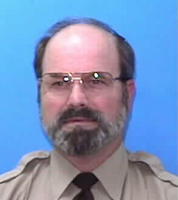
One woman had a very disturbing story about Rader. There was no
problem until after she got divorced and a new male friend came to live
with her. Rader kept issuing citation after citation for among other
things, items as trivial as having the wrong color garden hose.
He didn't like the "inoperable vehicle" in the driveway the male
friend was working on, and made it clear to the woman that if "he" left
the problems would cease. Rader started looking in her windows and one
day was found examining a door that had been mysteriously broken.
But it all culminated when Rader impounded her daughter's dog and
had it put to sleep before anyone could reclaim it. The lady immediately
moved out of Park City.
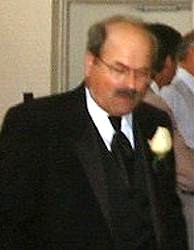
In a gender discrimination lawsuit filed in federal court, Rader's
co-worker Mary Capps, who worked under Rader from 1998 until his arrest,
alleged he was a terrible boss, cold, demanding and degrading.
She described one incident of being trapped in her office and chased
around the room, terrified. Capps stated that she complained weekly to
Rader's supervisor about his ongoing behavior but was dismissed or
simply referred back to Rader himself.
Three formal complaints to the city of Park City were, by city
procedures, channeled to her supervisor, Dennis Rader, who naturally did
nothing about them. There were media reports after the arrest stating
that Capps may have been drugged repeatedly with animal tranquilizers
while working with Rader, although this was not mentioned in this
lawsuit.
A federal judge has dismissed the lawsuit, saying it was not filed
within required time limits. (In 2001, Rader gave a brief interview to
Wichita station KSN-TV over an animal control incident, as related in
this story from KSN.com.)
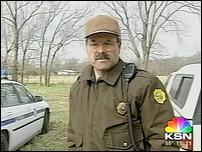
During the 1990s Rader served on two local boards in Park City. In
1996 his father William Rader died of natural causes. His mother
Dorothea eventually began staying in a nursing home or at home with son
Jeff.
Rader's daughter Kerri attended Kansas State University, whose
football team he was a huge fan of. In 2003 Kerri married a man from
Michigan and went there to live. Son Brian joined the Navy and left the
area for the East Coast.
Rader was elected to the church council and assumed the position of
vice president starting on January 1, 2004. According to church
procedure, the vice president becomes council president after one year.
The Raders remained quite active in their Lutheran church, with Dennis a
trusted leader, helper and usher. Despite all this, with the kids gone
Rader found himself increasingly bored.

The on-line Crime Library had published an article about the
unsolved BTK case. It was thought BTK was dead, jailed or
institutionalized perhaps. The subject had faded even in Wichita, and a
whole generation of Wichitans were growing up without much knowledge of
the case. Rader had thought about publicly reemerging later on in life.
But then all of sudden BTK became a topic of interest again.
BTK is Back
A Wichita lawyer named Robert Beattie was concerned that the BTK
case was being all but forgotten. He set out to write a book about the
investigation that tried so hard to capture this elusive killer, who he
still reasoned to be a potential threat to the public even though the
last known murder had occurred in 1977.
BTK was attributed with seven murders and the attempt on Anna
Williams in 1979. Beattie was responsible for renewed interest in the
BTK case as early as 2003, and the message board Crime and Justice began
discussing the case again on the Internet. January 2004 was the 30th
anniversary of the Otero murders, and the Wichita Eagle ran an article
about the crime and the BTK killer.
In conjuction with that came the announcement of the publication of
Robert Beattie's new book. These events more than captured Dennis
Rader's attention. He became alarmed that someone else would be telling
what was his own story, and suddenly his plans for an eventual
reemergence were greatly accelerated.

Rader fumed over what to do for the next couple months but then took
action. On March 17 he mailed an envelope to the Wichita Eagle from a
Bill Thomas Killman. It contained three photocopied pictures of his own
photos of the dying Vicki Wegerle taken in 1986, as well as a photocopy
of her missing driver's license.
He signed it with the BTK symbol he had used in his previous letters
in the 1970s. The letter was forwarded to the FBI who confirmed its
authenticity as a BTK communication. An old cold case was solved, but
the uproar had only just begun.

The dust hadn't begun to settle when Rader sent a second letter,
this time on May 5, 2004 to the studios of KAKE-TV, the Wichita ABC
affililiate. This was a lengthy word puzzle consisting of columns of
letters and a few numbers mixed in. The FBI verified that this also came
from BTK, as he characteristically used his unique signature, but
couldn't make any particular sense out of the puzzle.
On June 9, 2004 Rader left a package taped to a stop sign at the
corner of First and Kansas, in the middle of the city. This contained a
disturbing collection of documents, including a letter detailing the
grisly murders of the Otero family and a sketch of a nude and bound
female hanging by a rope.
Eleven year old Josephine Otero had been hanged by a rope in the
basement of their home in 1974. The sketch was labeled, "The Sexual
Thrill is My Bill." Also enclosed was a chapter list entitled "The BTK
Story" that mimicked the chapter list of David Lohr's original article
on BTK at the on-line Crime Library. Chapter One was entitled, "A Serial
Killer is Born."
On July 17, 2004 a package marked "BTK" was found in a book return
at the Wichita Public Library downtown. It contained a worrisome message:
"I have spotted a female that I think lives alone and/or is a
spotted latchkey kid. Just got to work out the details. I'm much older (not
feeble) now and have to conditions myself carefully. Also my thinking
process is not as sharp as it uses to be ... I think fall or winter
would be just about right for the HIT. Got to do it this year or next!
... time is running out for me."
This same package contained an intriguing claim that he, BTK, had
engineered the recent death of a 19 year old man from Argonia, Kansas,
named Jake Allen. Jake Allen had committed suicide by lying on railroad
tracks 12 days earlier. BTK claimed to have lured the young man to his
death via a series of computer chats. (This claim was later disproven as
a hoax, as there was no evidence that Allen had ever had any such
Internet chat with anyone, and his death is still seen as a suicide).
Despite huge pressure from the public, the police refused to release
many details of the packages from June on, as it was feared that hearing
these things could provoke BTK into a killing frenzy.

The fifth drop didn't occur until October 22, 2004 when a UPS worker
found a strange manila envelope while picking up the contents of the UPS
box at the Omni Center by Second and Kansas. This consisted of a very
disturbing assortment of cards that had images pasted on them, including
one of a bound woman with a look of sheer terror on her face.
One card contained a poem called "Death to Landwehr," a reference to
Lt. Ken Landwehr who was head of the BTK investigation. There was a
collage of pictures of children with bindings drawn across their bodies
and faces.
This envelope also contained what BTK claimed to be his
autobiography, listing a number of details about his life such as being
born in 1939, his father dying in the war, mother dated a railroad
detective and so on.
BTK claimed to be fascinated with railroads and usually lived near
railroad tracks. Almost all of it was actually false, an attempt to
mislead police into researching false clues. The police did release the
autobiography to the public a few weeks later, which undoubtedly would
have greatly pleased if not excited Dennis Rader.
What the Wichita Police Dept. was actually doing was following the
FBI's advice: keep the killer communicating. Don't offend him publicly.
Don't over-excite him into killing some more. Just keep communicating
until he makes a mistake.
On December 1, 2004 officers of the Wichita Police Dept. stormed the
house of Roger Valadez, who lived in a house in Wichita with peeling
paint within sight of railroad tracks. He was held on a minor
outstanding warrant, but apparently was suspected of being the BTK
killer. A DNA test quickly exonerated him however. Ultimately police
would take some 1,300 DNA swabs of men searching for a match to BTK's
semen left at crime scenes.

Rader's sixth drop was found on December 14, 2004. A man walking
through Murdock Park that night noticed a package wrapped in white
plastic leaning against a tree. Out of curiosity he took it home with
him and opened it. It contained a "PJ" doll. The doll's head had a
plastic bag tied over it. Its hands were tied behind its back and its
feet were bound together.
Tied to the feet was a real driver's license belonging to BTK murder
victim Nancy Fox whom he had killed in December 1977. The man
immediately notified KAKE-TV, who arrived and photographed the contents
and notified police. KAKE agreed not to broadcast what was found in the
package, for fear of arousing the killer.
On January 1, 2005 Dennis Rader officially became the new president
of the church council at Christ Lutheran Church in Wichita, as per his
election to the vice presidency the previous year.
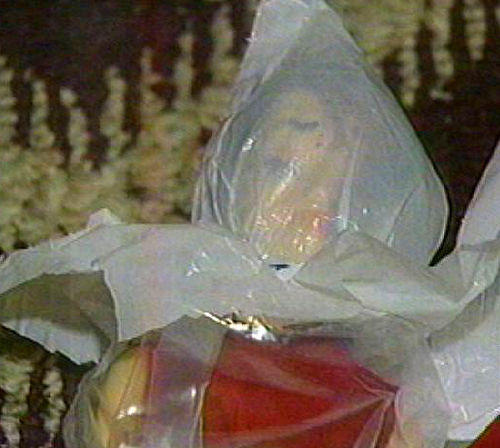
Eight days into the new year Rader left a Special K cereal box
marked "BTK" and "bomb" in the bed of a pickup truck parked at the Home
Depot on North Woodlawn. The truck belonged to an employee of Home Depot.
He thought it was trash at first and put it in a trash can at home.
Luckily his wife had thrown a discarded pillow on top of the box,
unwittingly preserving it.
Days later when the man realized the significance of the box he was
still able to retrieve it. By reviewing surveillance tape of the parking
lot for January 8 the police had their first glimpse of BTK, but the
image was too far away and blurry for identification. But by measuring
the wheelbase of the black vehicle he was driving it was determined the
vehicle was a Jeep Cherokee. Despite having installed alarm systems for
a living, Rader was apparently unaware that surveillance cameras had
become a commonplace item.

The box itself contained information about some of his "PJs" or
projects, intended victims that he had watched or stalked. It also
contained more misleading information of how he lived in a 3 story home
in Wichita with an elevator that had a bomb in the basement rigged to
explode if the house were invaded.
Rader also asked a peculiar question to the detectives: if he put
his writings on a computer disk, would it be traceable? He requested a
response to be posted in the Wichita Eagle classified ads in the
Miscellaneous category using his code name, Rex.
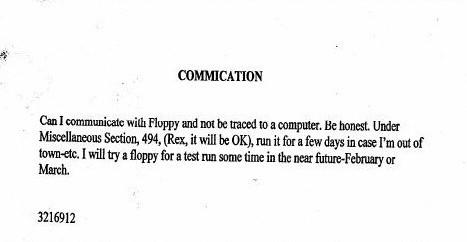
The eighth drop was another cereal box from the "cereal" killer,
this one a Post Toasties. It was discovered on January 25, 2005 as the
result of a tip from drop #9, which was a postcard sent to KAKE from an
S. Killet using as return address the address of the Otero house. Drop
#9 had mentioned the Post Toasties box and the drop at Home Depot on
January 8 (which triggered the investigation there that ultimately
located the Special K box).
The Post Toasties box was found leaning against a road sign on a
desolate unpaved section of North Seneca to the north of the Wichita
city limits. KAKE videotaped the box without touching it and notified
police. It had a brick on top of it and appeared weathered.

It was later revealed to have contained another doll, this one with
a rope tied around its neck and tied to a plumbing fixture, simulating
the hanging of Josephine Otero.
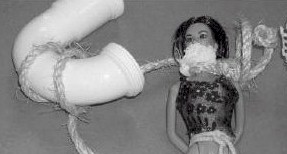
The tenth drop was another postcard that arrived on February 3,
again sent to KAKE. Return address was Happ Kakemann, a 1950s character
from KAKE's past. Rader wrote: Thank you for your quick response on
#7 and 8. Thank to the news team for their efforts. Sorry about Susan's
and Jeff's colds. Business issues: Tell WPD that I receive Newspaper Tip
for a go. Test run soon. Thanks. PS: May want to use KTV-PC-etc code #
and Letters from me for my Verification code to you. He was
referring to the newspaper ad in the Wichita Eagle placed there by
detectives to answer his question about the safety of sending in a
computer disk. The responding ad had assured him in agreed-upon code:
Rex it will be OK.

Drop #11 arrived at the studios of KSAS-TV on February 16, the Fox
affiliate in Wichita. It contained a letter, a piece of jewelry and a
purple diskette referred to as "Test Floppy for WPD review." Detectives
wasted little time analyzing the diskette and found software on it from
Christ Lutheran Church in Wichita and the name Dennis. Rader had
apparently thought he had erased the original contents of the diskette
and that it would be "safe" to use it for his purposes.

A quick Internet search brought up a website for the church
mentioning its current president, Dennis Rader. A group of detectives
quietly drove by Rader's house in Park City and noted a black Jeep
Cherokee parked in the driveway. Rader was placed under surveillance
while a subpoena was secretly obtained for a DNA sample of his daughter
from medical records.
The familial DNA was a match to DNA found from semen at BTK crime
scenes and the case was solved. (Contrary to early media reports, Kerri
Rader never suspected her father was BTK nor did she turn him in. She
was asked to submit a DNA sample directly at her home in Michigan within
an hour after the arrest, but never knew until later that her DNA had
been used to solve the BTK case.)
After leaving the office to eat lunch at home as was his custom, on
February 25, 2005 Rader was driving home when he noticed he was totally
surrounded by police, a huge number of them. He surrendered quietly and
was led to a waiting police car, handcuffed.
"Hello, Mr. Landwehr," he said once inside the car.
"Hello, Mr. Rader," Lt. Ken Landwehr responded.
dennisraderbtk.blogspot.com |




















